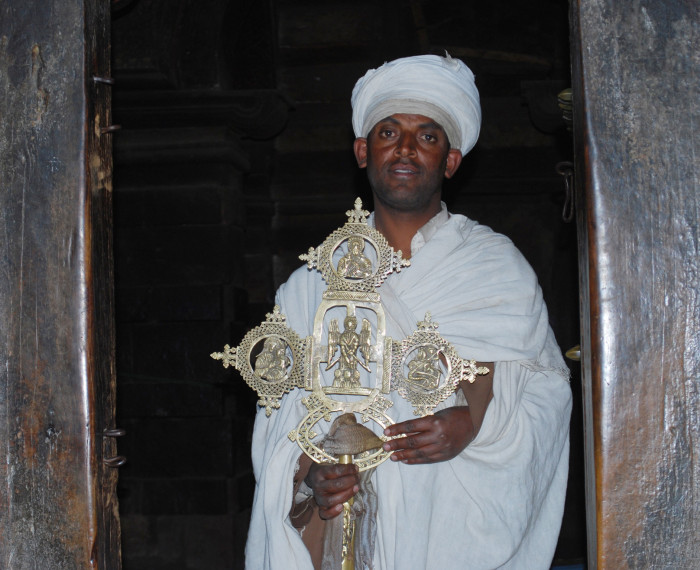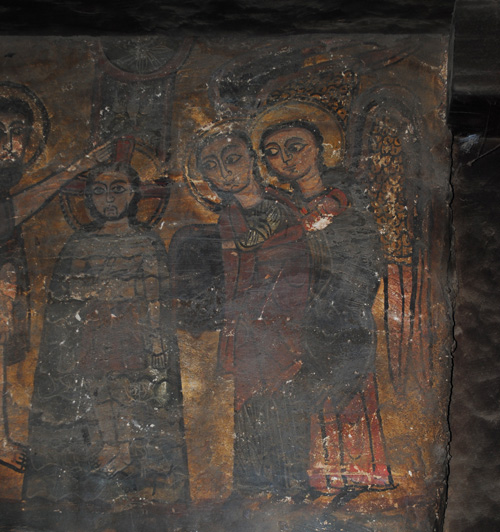The priest responsible for receiving pilgrims and tourists, at the entrance of the church of Yimrihane Kristos, display the procession cross made of some sort of precious metal and used in liturgical ceremonies. One of several artifacts belonging to this site. Presumable 12th century and most probably made in Ethiopia and maybe just in one copy. © SCECH
RESEARCH is more or less an integrated part of conservation and cultural heritage management. A study not just in conservation science, but also in a broad sense in humanities connected to SCECH’s planned project of conservation and education, with starting point on the site of Yimrihane Kristos (YK), has therefore a high priority. In our charter is stated: to work for an inter-disciplinary study of the historical, technical, cultural and religious issues associated with the religious architecture and art in Ethiopia, which becomes the subject for conservation, and for the publishing of this material.
In comparison with other cultures the knowledge of the ancient sacred art and architecture of Ethiopia is neglected. The lack of knowledge and literature in the subject is great, despite the fact that this artistically tradition constitutes a unique part of African art as a whole and of the World Heritage. The research in this field is still scant and only a handful of scholars have pursued regular studies in the history of Ethiopian sacred art and architecture since the middle of the last century. This can partly be explained by the fact that the art and architecture that constitute this cultural heritage in ancient monasteries and churches in the Ethiopian highlands is geographically hard to access. Another reason can be that the major part of the international association of scholars, which normally have their focus on art in Europe or in other parts of the world, has still not yet discovered this momentous branch of the African culture. This is strangely, not only with regard to the outstanding spiritual beauty and humble charm this architectural and pictorial culture radiates, but also as it constitutes an important part of the art and architectural history taken as a whole.
The Institute of Ethiopian Studies (IES), Addis Ababa University. International center for research not least within humanities. It has ”a mission to aid in the conservation of Ethiopia’s cultural heritages by collecting, cataloguing and displaying in museum objects reflecting and representing the material and spiritual cultures of the diverse ethnic groups of the country”. It was founded 1963 by Professor Richard Pankhurst and is situated in the former villa of Emperor Haile Selassie. Between this one is an annex building for the new IES Library under construction, that will be named after mentioned Professor. © SCECH
A cross-disciplinary research project, planned to go along with the Yimrihane Kristos Conservation and Education Pilot project, has been outlined by Britt-Inger Johansson, Professor of Art history at Uppsala University and member of the board of SCECH. This study, tentatively named The hidden and the forgotten, could elucidate the time of the Zagwe Dynasty, i.e. Ethiopian history of the 11th to 13th centuries. It will include studies in history and archaeology connected to this place, art and architectural history, church history, building-, painting- and conservation techniques including studies of used materials and methodology of building and painting conservation. It is plan to be done in collaboration between Swedish and Ethiopian scholars belonging to the universities of Lund, Uppsala and Gothenburg: Dept. of Conservation at GU and Dept. of Architecture at Chalmers University and Addis Ababa University, Dept. of History and The Institute of Ethiopian Studies.
Mäqdas, the Ethiopian name for the Sanctuary, placed in the eastern part of the nave, where the holy Tabot – the symbolic representation for the Arch of the Covenant – is kept, invisible for all but the priests, and the magnificently chiseled out and painted triumphal arch, in great need of cleaning. © SCECH
The main ambition of this research program, were the details still not yet are determined, would be to make an over all study of the buildings, which will be the subjects for conservation, i.e. the church and its artistic belongings and the so-called royal palace, as well as the spirit of the place – genius loci – in past and present time and the specific ecclesiastical history and spiritual traditions connected to this site. This would on the one hand take the form of monument mapping and research where chosen physical and artistic facts of value would be included:
One of several beautifully carved and originally painted windows of the southern wall of the church. All of them are made in different design and pattern and testify to a craftsmanship tradition of highly sophisticated art. Presusumable from the 12th century. Provenience unknown. © SCECH
As to the buildings: external and internal measurements (also 3D plans) and technical measurements of walls and plaster with high-tech methods as regards architectural conservation; photographic documentation in different techniques including detail photography of building technique and craftsmanship; stipulating of the building history, construction and materials; architectural design and traditions of craftsmanship reflected in architectural details.
Detail from the Baptist, one of several Christological motives that adorn the Church. Mural painting, al secco, on the northern wall in the north aisle, in great need of conservation. Presumable 12th century. Reminding of medieval Coptic painting, but attribution still unknown. © SCECH
As to the paintings and artifacts: determination of origin, artistic execution, pigments and its binders of murals and decorative painting, including x-ray photography in order to find out possible hidden damages and earlier painting underneath visible painting layers and ordinary photographic documentation; studies of the pictorial program and decorations of the church in relation to the architectural language with regard to the spiritual content and liturgical function, including various artifacts belonging to this church, i.e. altars, moveable icons, crosses, manuscripts: bibles, prayer books and other liturgical books.
On the other hand and closely related to the latter a study of the overall history and church history connected to this site and time in the Ethiopian history, including archaeological investigations here and in the nearby of this site, which may verify or falsify certain hypothesis. And last but not least how the pious people in the society of Yimrihane Kristos themselves today with their since centuries ancestral traditions are related to this site as a holy place and the spirit that here prevails – genius loci – and at the same time as a heritage site and tourist attraction and how this peaceful place of prayer and devotion stands in relation to the local, national and international wish to make this to a world heritage site, welcoming large crowds of people, also with regard to economic development.

Timqat in Addis Ababa 2008. During Timqat (the yearly feast of the baptism of Jesus) millions of people are gathered together in joyful celebration in the streets of the Capital as in all cities of the country and so also in the villages in the Ethiopian highlands. This is also happening in the heritage site of Yimrihane Kristos, where art and piety are deeply interlaced. The spirit of the hearts of the people and the spirit of the place – genius loci – are one. © SCECH
The results of this cross-disciplinary study is plan to be published in scholarly journals and after finished conservation partly be published in a richly illustrated monograph on the Yimrihane Kristos site, which will shed light on the hidden and forgotten in Ethiopia’s history during the Zagwe era. This monograph will, besides the splendor these buildings and its artistic adornments after conservation will convey as such, present an important part of Ethiopia’s history and cultural heritage firstly to its own people, but also to the international community.
Links:
More detailed information on Inter-disciplinary research connected to the YK project – The hidden and the forgotten (page in progress)
SCECH’s Charter Addis Ababa University, IES, EiABC Lund University: Faculties of Humanities and Theology, Uppsala University Chalmers University: Dept. of Architecture, Gothenburg University: Dept. of Conservation





Lämna ett svar
Du måste vara inloggad för att publicera en kommentar.